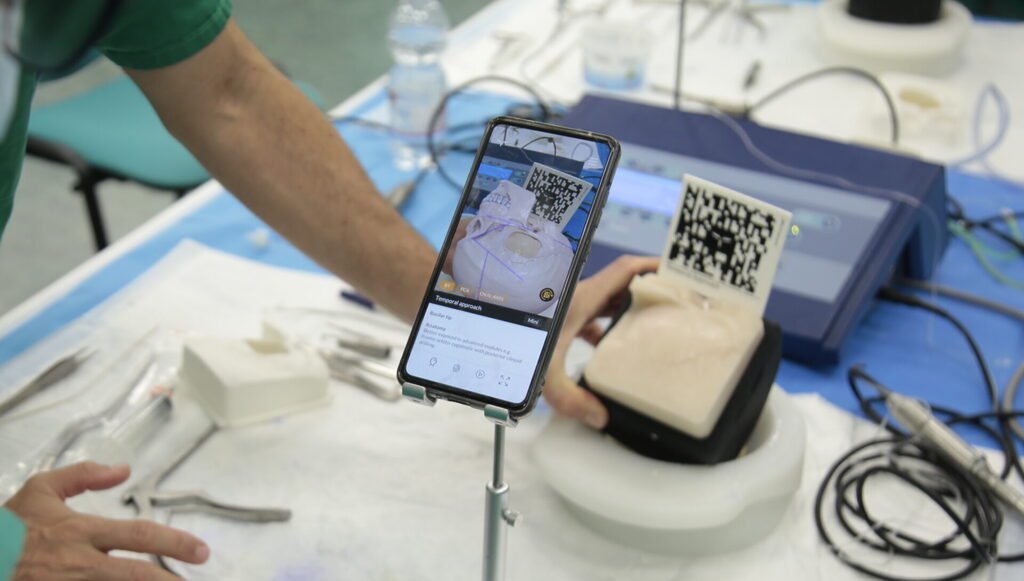Artificial Intelligence (AI) is transforming how doctors monitor spinal fusion success over the long term, ensuring that patients continue to experience positive outcomes months and even years after surgery. Traditional follow-up methods often rely on periodic visits and limited patient reporting, but AI-driven tools provide continuous, data-rich insights that give healthcare providers a clearer view of each patient’s progress. Dr. Larry Davidson, an expert in spinal surgery, recognizes that AI’s ability to track and analyze patient data over extended periods allows for proactive care, helping to maintain spinal health and overall well-being long after the initial recovery phase.
Continuous Tracking of Patient Outcomes
AI’s continuous monitoring of spinal fusion recovery offers long-term insights by tracking spine health through wearable devices, imaging and patient-reported data. This enables healthcare providers to assess fusion stability over months or years, detecting subtle changes in mobility, flexibility or pain that may signal complications like weakening fusion or hardware issues. Early detection allows prompt intervention, preventing minor issues from escalating.
In addition to physical indicators, AI can also track psychological markers, helping healthcare providers support both physical and mental recovery. This holistic, proactive approach is vital for comprehensive, long-term spinal fusion success.
Detecting Late-Stage Complications
While most spinal fusion complications arise shortly after surgery, some issues may develop much later. AI’s predictive analytics help detect these late-stage complications by identifying patterns from similar cases, allowing early intervention. For example, AI can flag declines in spinal alignment or stability, alerting healthcare providers to issues like inflammation, hardware loosening or improper healing before they worsen. This proactive approach is crucial for long-term spinal health. It helps patients maintain pain-free mobility and stability and supports their quality of life for years after surgery.
Personalizing Long-Term Care Plans
Another key advantage of AI in long-term spinal fusion recovery is its ability to personalize care plans based on each patient’s unique recovery trajectory. AI allows healthcare providers to tailor follow-up care to the specific needs of everyone, recognizing that every patient heals differently. By analyzing data collected over time, AI can pinpoint which patients may require more frequent follow-ups, additional physical therapy or other types of support.
For instance, if AI detects that a patient’s recovery is slower than expected, it might recommend modifying their physical therapy regimen or conducting additional imaging to assess the fusion’s integrity. Conversely, if a patient shows faster-than-expected progress, AI can suggest advancing their physical activity or reducing follow-up appointments, allowing them to resume daily activities with confidence. This flexibility ensures that patients receive care that aligns with their personal recovery needs, reducing the likelihood of complications and improving overall outcomes.
By making care plans dynamic and responsive, AI enables a more individualized approach to post-surgery care. This personalized guidance is particularly beneficial in spinal fusion recovery, where a one-size-fits-all approach is often insufficient. With AI’s help, healthcare providers can adapt care plans based on real-time data, giving each patient the support they need at every stage of their recovery journey.
Enhancing Patient Engagement Post-Surgery
AI also plays a critical role in keeping patients engaged in their recovery process well beyond the initial surgery. By using AI-driven mobile apps and platforms, patients can track their progress and stay informed about their spinal health. This engagement empowers patients to take an active role in their recovery, giving them insights into how well their spine is healing and alerting them to any potential issues that may need attention.
Through reminders for follow-up appointments, daily exercises and self-care practices, AI helps patients stay on top of their rehabilitation routines. This consistent engagement fosters a sense of accountability and allows patients to stay proactive about their health, which is vital to successful long-term recovery. In addition, real-time feedback on daily activities—such as posture, lifting habits and movement patterns—helps patients understand how their actions affect their spine, encouraging them to adopt healthier habits that support recovery.
By offering ongoing insights, AI ensures that patients remain connected to their progress and motivated to maintain their spinal health. Knowing they have a reliable way to monitor their recovery provides patients with peace of mind, helping them stay focused on their long-term well-being and making the rehabilitation process more manageable.
The Future of AI in Long-Term Spinal Fusion Monitoring
As AI technology advances, its role in monitoring spinal fusion recovery will continue to evolve. Future developments may introduce even more sophisticated predictive analytics that can anticipate potential recovery challenges before they arise, allowing healthcare providers to preemptively adjust treatment plans. By using AI’s predictive capabilities, recovery strategies could become increasingly personalized and adaptable, further improving long-term outcomes.
The integration of AI with emerging technologies, such as Augmented Reality (AR) or Virtual Reality (VR), may also transform the recovery experience. AR or VR could provide patients with interactive, visual feedback on their recovery progress, making exercises more engaging and offering real-time guidance on proper movement techniques. Additionally, AI-powered virtual consultations could improve access to specialized care for patients in remote areas, allowing them to receive expert support throughout their recovery.
Another promising application is the potential for AI to facilitate collaboration among healthcare providers. By aggregating data from multiple sources—such as physical therapists, surgeons and primary care physicians—AI can provide a comprehensive view of a patient’s progress, ensuring that each member of the healthcare team contributes to a coordinated recovery plan. This integrated approach helps maintain continuity of care, offering a smoother recovery experience.
Transforming Long-Term Spinal Health Through AI
AI is revolutionizing the long-term monitoring of spinal fusion patients by continuously tracking recovery, detecting late-stage complications and personalizing care plans. Dr. Larry Davidson says, “AI will provide us with the ability to have a total and comprehensive understanding of the patient’s medical history.” This will allow surgeons to identify the best practices for spinal interventions. These advancements are enabling patients to maintain spinal health and high quality of life well beyond the initial surgery. By providing data-driven insights, AI empowers both healthcare providers and patients to take proactive measures that ensure positive long-term outcomes.
As AI technology continues to develop, its ability to support spinal fusion recovery will only increase, setting a new standard in post-surgical care. With its potential for predictive analytics, patient engagement and collaborative care, AI promises a future where spinal fusion patients receive comprehensive, personalized and effective long-term support for their spinal health.









